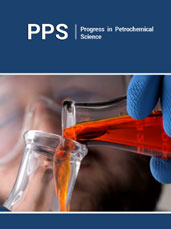- Submissions

Abstract
Progress in Petrochemical Science
Eco-Insights on Hydrocarbon Bioremediation
-
Open or CloseMaria Fátima Nunes Serralha and Ana Cláudia de Sousa Coelho*
Polytechnic Institute of Setúbal, Escola Superior de Tecnologia do Barreiro, Department of Chemical and Biological Engineering, Portugal
*Corresponding author:Cláudia de Sousa Coelho, Polytechnic Institute of Setúbal, Escola Superior de Tecnologia do Barreiro, Department of Chemical and Biological Engineering, Portugal
Submission: April 05, 2024; Published: April 19, 2024

ISSN 2637-8035Volume6 Issue2
Abstract
Microorganisms are ubiquitous in the biosphere, influenced by both their surrounding environment and the biotic and abiotic factors of ecosystems. Contaminated areas often harbor species adept at utilizing pollutants as nutrients, thus enhancing their resilience to environmental pressures. Identifying and characterizing these species can significantly benefit bioremediation processes. To contribute to this understanding, bioremediation experiments were conducted in Barreiro, a pivotal industrial hub in Portugal during the 20th century. Soil samples from two distinct locations were analyzed: one near Barreiro city, impacted by various anthropogenic activities leading to increased fuel pollutants and the other in a protected wooded area designated for recreational and educational purposes. All identified hydrocarbon-degrading microorganisms belonged to the Pseudomonas genus. Bioremediation assays isolated bacteria from pure colonies, compared with mixtures of all bacterial morphotypes capable of growth in the pollutant’s presence. Consistently higher bioremediation rates for gasoline and toluene were observed using mixed cultures. Effective degradation-capable bacterial strains were identified in both locations, demonstrating bioremediation potential. Mixed bacterial cultures exhibited superior degradation rates, underscoring the importance of microbial diversity for bioremediation effectiveness. Also, the composition and bioremediate activity of microbial communities change in response to hydrocarbon concentration were analyzed, providing insights into the resilience of microbial communities to environmental stressors and their capacity to adapt to contaminated conditions. These findings emphasize the importance of in-depth, on-site investigations to elucidate the interplay between native microbial communities and pollutant degradation potential in soil.
Keywords:Soil bioremediation; Hydrocarbonoclastic microorganisms; Barreiro municipality; Pseudomonas
 a Creative Commons Attribution 4.0 International License. Based on a work at www.crimsonpublishers.com.
Best viewed in
a Creative Commons Attribution 4.0 International License. Based on a work at www.crimsonpublishers.com.
Best viewed in 







.jpg)






























 Editorial Board Registrations
Editorial Board Registrations Submit your Article
Submit your Article Refer a Friend
Refer a Friend Advertise With Us
Advertise With Us
.jpg)






.jpg)














.bmp)
.jpg)
.png)
.jpg)










.jpg)






.png)

.png)



.png)






